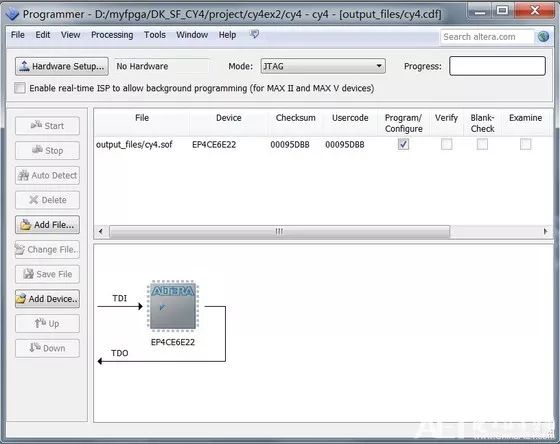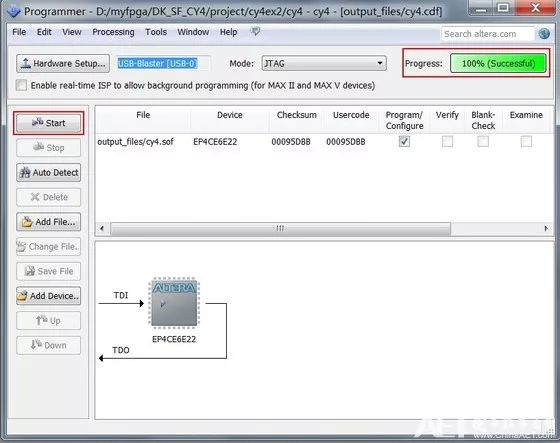PWM buzzer driven FPGA online download configuration diagram
Begin by connecting the USB Blaster download cable to your computer and the SF-CY4 board. Power on the board, then open the project located in the "...\prj\cy4ex2" directory by double-clicking the file "cy4.qpf". As shown in Figure 7.18, click the "Programmer" button from the menu bar to access the download configuration interface.

Figure 7.18: The Programmer Button
Once you're on the download page (as seen in Figure 7.19), make sure the "Mode" is set to "JTAG". Check that the file under the "File" column is "output_files/cy4.sof", and ensure the "Program/Configure" option is selected.

Figure 7.19: Programmer Configuration Page
Next, verify that Quartus II recognizes the USB Blaster. If it doesn't, click on "Hardware Setup..." located in the top-left corner of Figure 7.19.
As shown in Figure 7.20, a new window will appear. Select "USB Blaster" as the current hardware and close the window. If the USB Blaster is not listed, first check that the cable is properly connected between the USB Blaster and your PC. Try unplugging and reinserting the cable several times, or restart the Quartus II software if necessary.

Figure 7.20: Hardware Setup and Selection
After confirming all settings, you can start the download process by clicking the "Start" button on the right side of the screen, as shown in Figure 7.21. Monitor the progress indicator in the upper-left corner to ensure it moves from 0% to 100%. Once completed, you should hear a clear "drip" sound from the buzzer on the SF-CY4 board.

Figure 7.21: Download Operation
The JTAG mode is used to program the FPGA with the .sof file generated from your project. However, note that once the power is turned off and back on, the code loaded via JTAG will be lost. This is because JTAG programming is volatile. If your configuration chip is programmed to blink, it will continue to do so after rebooting. To test whether the JTAG-loaded data is lost upon re-powering, you can first program the configuration chip with a non-flashing code, then perform the JTAG download again and observe the result. This helps distinguish between volatile and non-volatile configurations.
HP Laptop 15-FC 15-FD,HP laptop 15-FC keyboard,HP laptop 15-FD keyboard,HP 15-FC back cover
S-yuan Electronic Technology Limited , https://www.syuanelectronic.com